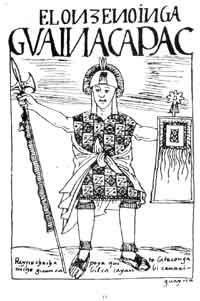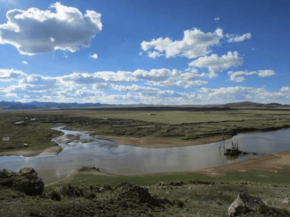Huayna Capac facts for kids
Quick facts for kids Wayna Qhapaq |
|
|---|---|

Wayna Qhapaq, drawn by Felipe Guaman Poma de Ayala. The title, in Poma de Ayala's nonstandard spelling, reads: El onceno inga Guainacapac, "The Eleventh Inca, Guayna Capac".
|
|
| Sapa Inca of the Inca Empire | |
| Reign | 1493 – 1524 |
| Predecessor | Tupaq Inka Yupanki |
| Successor | Waskar and Atawallpa Ninan Cuyochi (titular) |
| Born | c. 1468 Tumebamba or Cusco, Peru |
| Died | 1524 (aged c. 55–56) Quito |
| Consort | Kuya Kusi Rimay, Kuya Rawa Ukllu |
| Issue | Ninan Kuyuchi, Waskar, Atawallpa, Thupaq Wallpa, Manko Inka Yupanki, Atoq, Paullu Inka, Kispi Sisa, Coya Asarpay, Konono, and others |
| Inca | Runa Simi, Qhapaq Simi |
| House | Tumipampa Ayllu |
| Dynasty | Hanan Qusqu |
| Father | Inka Thupaq Yupanki |
| Mother | Kuya Mama Ukllu |
Huayna Capac (born around 1464 or 1468, died 1524) was a powerful leader of the Inca Empire. He was the third Sapan Inka (which means "Unique Sovereign") from the Hanan dynasty. He was also the eleventh ruler of the entire Inca civilization. People often called him "Wayna Qhapaq Inka Sapa'lla Tukuy Llaqt'a Uya," meaning "Unique Sovereign Wayna Qhapaq Listener to All Peoples." His birth name was Titu Kusi Wallpa. He followed his father, Tupaq Inka Yupanki, as ruler.
Early Life and Family
The exact date and place of Wayna Qhapaq's birth are not fully known. He was raised in Cusco, the Inca capital. However, he might have been born in 1468 in Tumebamba (which is now Cuenca). He also spent some of his childhood there.
Wayna Qhapaq's father was Thupaq Inka, who ruled from 1471 to 1493. His father had already expanded the Inca Empire north into what is now Ecuador. Wayna Qhapaq continued this expansion.
Wayna Qhapaq had many children. His main royal wife was Koya Rawa Okllo. They had a son named Thupaq Kusi Wallpa, also known as Waskar.
Other important sons included Ninan Kuyuchi, Atawallpa, Thupaq Wallpa, and Manko Inka. Some of these sons later became Sapan Inka themselves. His daughters included Azarpay and Kispe Sisa.
Leading the Empire
When Wayna Qhapaq was young, he had a tutor named Wallpaya. This tutor tried to take over the empire, but his plot was discovered and stopped.
Wayna Qhapaq continued to expand the Inca Empire to the south. He added lands that are now part of Chile and Argentina. He also tried to expand north into Ecuador and southern Colombia.
In Ecuador, Wayna Qhapaq brought the Quito Confederation into the Inca Empire. He married the Quito Queen Paccha Duchicela Shyris XVI to end a long war. Their son, Atawallpa, was born in Caranqui, Ecuador. Wayna Qhapaq spent a lot of time in Ecuador. He even rebuilt Quito to be like a "second capital" for the empire. He also founded new cities there, like Atuntaqui.
As Sapan Inka, he also built special places to study the stars, called astronomical observatories, in Ecuador. One famous example is Ingapirca. He also had a country palace called Kispiwanka in the Sacred Valley of Peru.
In what is now Bolivia, Wayna Qhapaq helped develop Cochabamba. This became an important center for farming and managing the empire. More than two thousand storage buildings, called qullqas, were built there to hold corn.
Wayna Qhapaq really liked the central Peruvian Andes mountains. He often relaxed at the Chinchaycocha lake. Many Inca rafts were brought there from Ecuador just for his enjoyment.
The Inca Empire reached its largest size and power under Wayna Qhapaq's rule. It stretched over much of what is now Bolivia, Peru, Argentina, Chile, Ecuador, and southwestern Colombia. The empire included many different landscapes, from high mountains to thick swamps. It had over two hundred different groups of people, each with their own customs and languages. The empire was about 3,500 kilometers (2,175 miles) long from north to south. It included the Pacific Ocean coast, the Andes mountains, and parts of the Amazon basin.
The Inca Empire, also called Tawantinsuyu (meaning "the united four regions"), was very advanced for its time. It had huge cities, temples, amazing stone fortresses, roads cut through mountains, and large farming terraces. Wayna Qhapaq worked hard to improve the lives of his people. He expanded the road network greatly. He also had storehouses, called qollqas, built along the roads. These storehouses held food so that people in need could quickly get help.
Wayna Qhapaq knew that the Spanish had arrived near the coast of his empire as early as 1515.
Death and Its Impact
Wayna Qhapaq died in 1524. He had become sick with a fever while traveling in what is now Colombia. This sickness was likely a European disease, like measles or smallpox. The Spanish had brought many deadly diseases to the Americas. Native Americans had no protection against these illnesses. Millions of people died in this epidemic, including Wayna Qhapaq's brother and his oldest son, Ninan Kuyuchi, who was supposed to be the next ruler.
After Wayna Qhapaq's death, his sons Atawallpa and Waskar became rivals. Some sources say Wayna Qhapaq divided the empire between them. Atawallpa received the northern part, centered in Quito, and Huáscar received the southern part, centered in Cuzco. Other sources say Atawallpa was just a governor for his brother.
For a few years, the brothers ruled peacefully. But then, Waskar tried to take full control and had Atawallpa arrested. Atawallpa escaped and gathered support from Wayna Qhapaq's best generals, Chalkuchimac and Quizquiz. Atawallpa then fought against his brother in a civil war and won. He imprisoned Huáscar.
Pizarro and his Spanish soldiers arrived in the Andes mountains just as Atawallpa was returning to Cuzco after his victory. Pizarro launched a surprise attack in Cajamarca, killing many Inca soldiers. He took Atawallpa prisoner. To be set free, Atawallpa promised to fill a large room with gold and silver. This became known as Atahualpa's Ransom Room. For months, people brought precious objects from all over the empire. These included golden plates from the Sun Temple of Qurikancha in Cuzco.
On May 3, 1533, Pizarro ordered all the gold melted down. This took many weeks. On July 16, the melted treasure was shared among his men. Ten days later, Pizarro had Atawallpa executed.
Lost Mummy
All Inca emperors had their bodies preserved after death through mummification. Wayna Qhapaq's mummy was displayed in his palace in Cuzco. The Spanish explorers saw it there. Later, his family and servants moved it to his royal estate of Kispiwanka to hide it from the Spanish.
Eventually, the mummy was brought back to Cuzco. In 1559, the Spanish found it again. Along with the mummies of 10 other Inca emperors and their wives, Wayna Qhapaq's mummy was taken to Lima. They were displayed in the San Andres Hospital. However, the mummies did not last well in Lima's damp climate. They were eventually buried or destroyed by the Spanish.
In 2001, archaeologists tried to find the mummies of the Inca emperors under the San Andres hospital. They found a crypt, but it was empty. The mummies might have been moved when the building was repaired after an earthquake.
See also
 In Spanish: Huayna Cápac para niños
In Spanish: Huayna Cápac para niños



